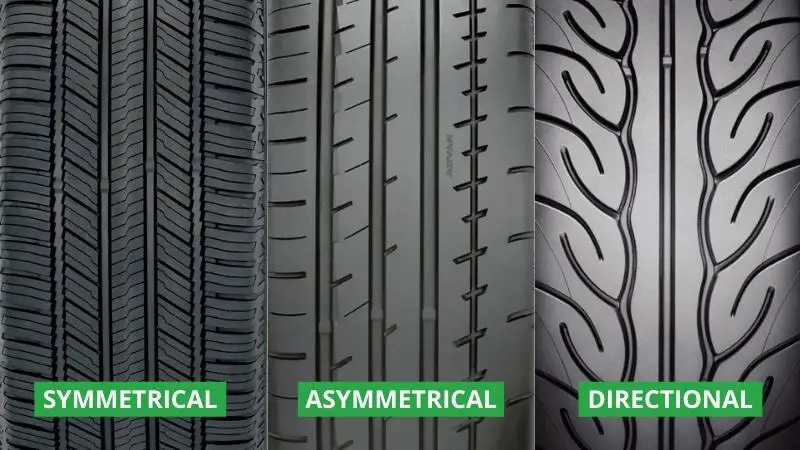It is easy to think that tires are the least complex elements of a vehicle and that creating them takes less effort.
While this might be somewhat true, much research and design elements are put into producing tires for automobiles in today’s world.
Unlike older tires made of pure rubber, today’s tires are diligently woven with layers of high-quality rubber compounds and a mixture of steel belts to make them stronger and more durable.
Every driver knows that the tire tread is the part of the tire that comes into direct contact with the road surface. However, not many pay attention to the specific tire patterns and how they affect the vehicle’s performance. Different tires provide extra traction and handling when tested on various road conditions.
Tire tread patterns are some of the delicate elements that R&D departments spend most of their time trying to figure out.
There are four different tread patterns that are designed to perform differently and achieve specific results, and they are:
- Directional
- Symmetrical
- Asymmetrical
- Directional/Assymetrical combination (Very uncommon)
In this post we will take a deep dive into the four common tread patterns that are used on modern cars, including their pros and cons.
But before we get to that, let’s find out why tires have treads in the first place.
Why do Tires Have Treads?
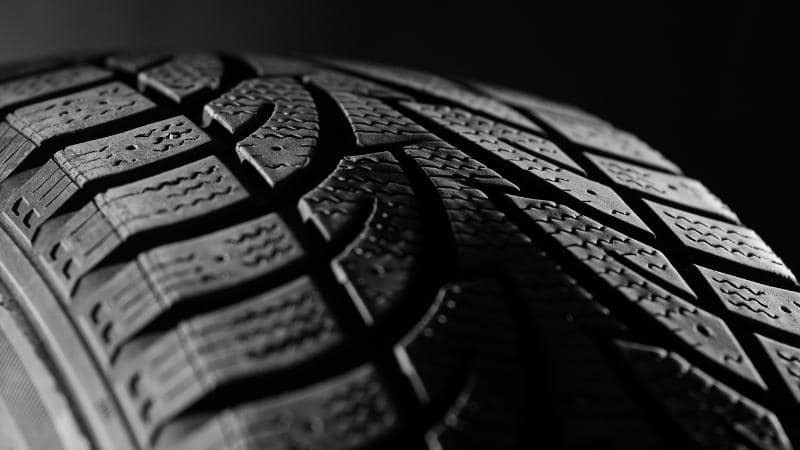
Tires are built with different tread patterns and depths to help people drive safely and comfortably. Regular cars have treads to provide stability of the vehicle when driving on various road surfaces. Grooved treads channel and pass water from under the tires.
Proper water dispersion lowers the likelihood of hydroplaning when driving on slippery roads. Treads give the tires the ability to maintain the proper grip and contact patch with the road surface. Good traction is good, especially when driving on sand, mud, dirt and snow.
Correct tread sizing improves grip, which facilitates proper steering and handling. In addition, the grooves can absorb ground noise and dissipate heat building up in the tires due to friction between the road and the tire surfaces.
The design and depth of the treads will also determine your tire’s longevity. Tire makers use unique patterns that will provide maximum wear and tear resistance. Tires without treads especially racing and performance specs, last for a shorter time compared to regular tires with deeper grooves.
What Are The Features of a Tire Tread?
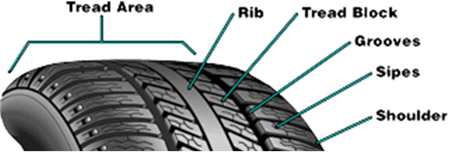
Apart from the tread patterns, subtle features make each tread different from the other on the tires. Here is a breakdown of the tread features to help you understand everything about the various tire tread types.
1. Tire lugs (Tread area)
The tire lug is the most crucial part of the tire. It is the main component of the tread where features and patterns of the tread are curved or added.
The tread lugs provide proper traction between the tires and the road.
2. Sipes
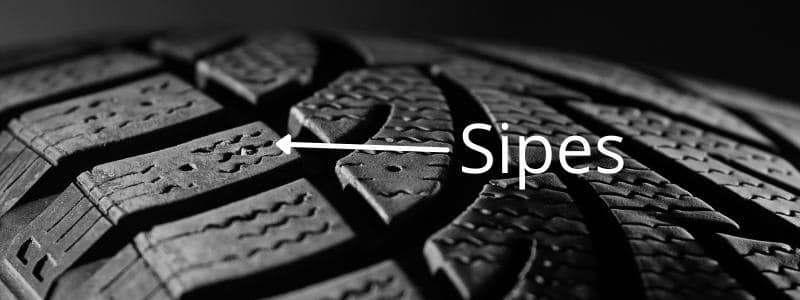
Sipes are the narrow spaces and throughways found on the tire lug. They are usually around 0.3-1.5 mm wide.
They are placed there purposely to improve tire traction on wet road conditions like snow or during rainfall. These passageways let the water run below the tire surface to help develop resistance against aquaplaning.
3. Tread rib
Tread ribs are also called transverse voids, and they are circumferential contact bars or ribs that circle the tire tread.
4. Tread groove
These tread parts appear depressed just like the sipes, only more prolonged and more profound. The grooves contribute to the particular tread pattern, with the sizes and shapes being calculated to improve a tire’s quality.
Overall, these features are designed to improve tire braking and steering control. The depth and pattern of the grooves can also determine the noise levels on the wheels.
5. Dimples
Not many tires have dimples but those that do use them to cool the tires.
6. Tread voids
Voids are similar to sipes because they create extra space needed for passing water beneath the tire surface when driving on wet surfaces. They improve traction because the water is dispersed through the wider channels along the axis.
Tread voids and lugs have a great relationship that directly impacts a tire’s overall contact patch. Therefore, the more gaps a tread has, the better the performance on wet surfaces. However, it may affect a tire’s grip when driving on dry surfaces.
Therefore, a car tire will have a specific number of voids depending on its purpose. Summer tires will have fewer tread voids than winter tires. All-season tires will have a balanced number of tread voids for all-time driving.
The Four Tread Patterns Explained
1. Directional Tread Pattern
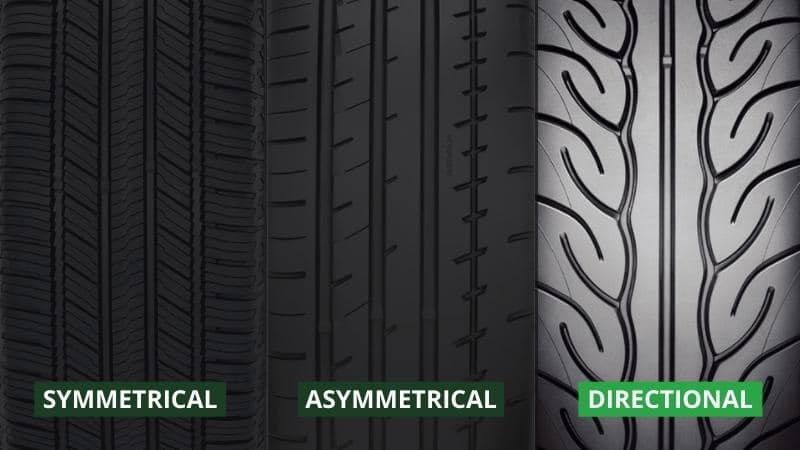
Tires with a directional tread pattern are designed to rotate in one direction. When you look closely, you will see that the lateral voids and sipes point forward and downwards. The channels on either side of the tread move like two waterfalls connecting from opposite sides.
Directional tire tread patterns are designed for performance cars and high-speed travels. They have better passageways to pass water for better aquaplaning resistance compared to asymmetrical and symmetrical patterns. The directional pattern also improves sports performance when driving on dry surfaces.
Tires with directional tread patterns cannot be shifted to different positions on the car. You can only use them from front to back on the same side to follow the direction pattern.
Features
- Excellent vehicle handling when driving on mud or snow
- Increased contact with the road when at high speed
- Highly resistant against aquaplaning
Pros
- Improved braking and traction
- A good option for better driving
- Enhanced water dispersal to improve stability on wet roads
- Suitable for all-season non-performance vehicles
- Better fuel efficiency
Cons
- Must be installed with the proper orientation because they are unidirectional
- Rotation limitations mean that they wear out quickly
- More costly than other types of tire treads
2. Symmetrical Tread Pattern
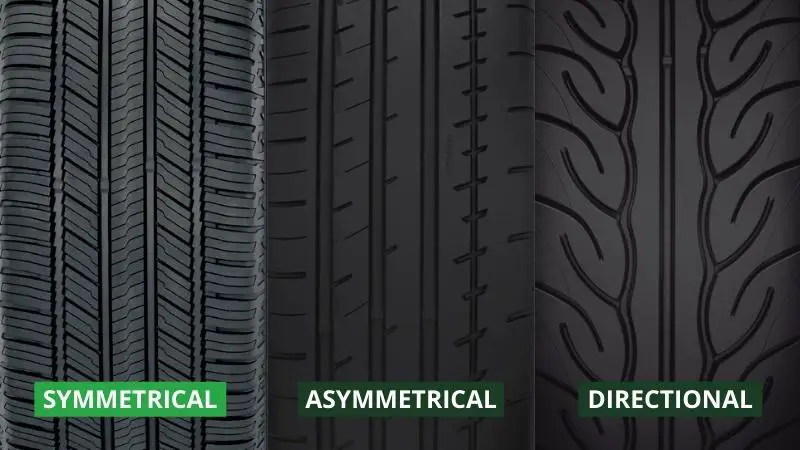
Most passenger car tires use symmetrical patterns. This pattern has the inner and outer sides of the tread looking symmetrical— treads on both sides mirror each other. Likewise, you will find that tread blocks on these tires have continuous ribs circling the entire tire.
Symmetrical tread patterns mean that the tires can be installed to rotate in all directions. Either front-to-back, back-to-front, or across (X-pattern). Tires with these tread patterns are more flexible and versatile, so they cannot interfere with day-to-day performance.
They are known to reduce noise, last longer, and improve fuel economy. However, they adapt poorly to changing road conditions.
Features
- Smooth and less bumpy rides
- High directional rotation stability
- Reduced rolling resistance
Pros
- It is a common pattern
- Has proper handling abilities
- Affordable and durable
- Multiple rotation directions
Cons
- Only suitable for daily use
- It cannot be used on wet road surfaces
- Not ideal as high-performance tires
3. Asymmetrical Tread Pattern
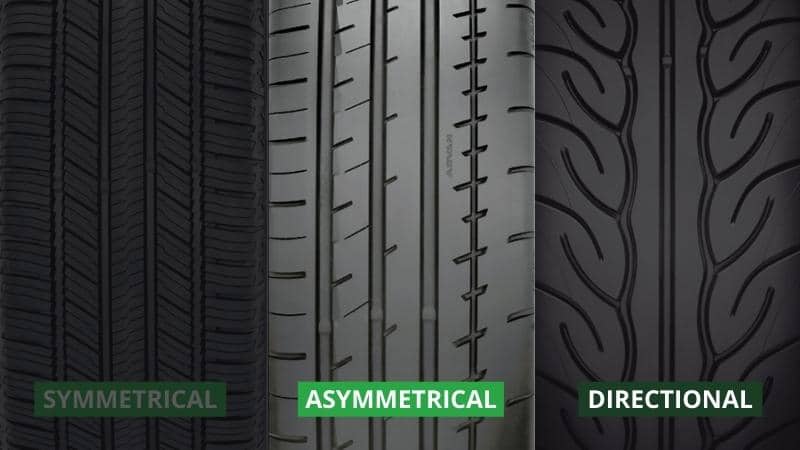
Asymmetrical tread patterns are, just as the symmetrical ones, commonly used on passenger cars. These tires have two distinct tread designs, one on the outer half and the other on the inner half of the tire. As unusual as it may sound, both halves are specifically designed for different conditions.
The inner tire tread is good for displacing water from the tire surface and protecting against aquaplaning. The outer half of the tread is built with rigid treat blocks to increase the lateral stiffness. All these features aim at providing a high grip for cornering or driving on dry road surfaces.
This combination makes asymmetrical tires a good option for ultra-high performance vehicles. When driving at higher speeds, the vehicle’s weight is exerted on the outer edge of the tire, meaning that more contact patch is good. The tire’s inside shoulder most likely has more grooves than the outer shoulder to increase water channeling.
Features
- Proper vehicle handling
- Increased stability in curves
- Have sufficient grip when driving on wet road conditions
- Two different block designs
Pros
- Reduced road-noises
- Provides good directional control
- Improved driving power and braking
- Safe for all kinds of weather
- Usable for multiple rotation methods, i.e., Front-to-back, back-to-front or x-pattern
Cons
- It does not perform better at high speeds like specialized designs
4. Directional/Asymmetrical Combo Tread Pattern
This tread pattern combines the two popular tread designs— asymmetrical and directional. This tread pattern is rarely found on cars because it is reserved for ultra-high performance tires. Tires with this tread pattern are only mountable in one way and can be placed either on the left or right side of the vehicle.
If the tires are not staggered, they can rotate front to back. If the vehicle is staggering due to fitment, the tire’s position must be maintained to increase its lifespan.
Features
- Better handling compared to other patterns
- Improved vehicle stability, cornering, and braking
- Different tread blocks for better performance
Pros
- Safe for all-season driving
- More long-lasting compared other tread patterns
- Increased steering and handling
- Proper water dispensing abilities on wet surfaces
- Improved grip on dry surfaces
Cons
- Very costly
- This tread pattern is very uncommon
- Reserved for ultra-high performance, meaning they are not safe for daily use
Can You Mix Tread Patterns?
If you are buying new tires, avoid mixing different sizes, types, or brands of tires on one vehicle. To get the best results, buy an identical set and model of tires to the ones already installed on your car. Doing this ensures that you maintain optimal performance characteristics.
Alternatively, it is much safer to replace a pair than a single tire when replacing your tires. The newly added tires should be placed on the rear axle and the almost worn-out tires on the front axle. If you cannot achieve this, you should ensure the replacement tires take the same tread pattern as the axle.
Mixing patterns significantly impacts the car’s handling abilities, and it can be dangerous for your driving experience.
Where Can I Find Which Tread Pattern I Have on my Car?
All tire manufacturers in the United States must follow standards and guidelines provided by the Tire and Rim Association. These bodies also partner with major tire manufacturers in Europe, Japan, South America, and parts of Asia.
Tires come in different types and sizes that determine how they perform. These types and sizes also determine the suitability of a particular vehicle and whether they fit your driving needs. Your owner’s manual has all the information that will guide you towards understanding the appropriate tire types and sizes for your car.
All information about your car tire is found on the current tires sidewall (if they are the same tires that came with your car), and you should check it before getting a replacement.
Frequently Asked Questions
What Tread Pattern Should You Use During Winter?
Winter driving needs tires that improve steering and braking. This means that you should go with directional tire patterns, proven effective for winter conditions because they have better handling.
They also have deeper grooves that disperse a lot of water, increasing grip on wet road conditions.
Can You Use Two Different Tire Treads on One Car?
While this is not advisable, some situations can allow you to use different tread patterns for excellent traction and stability on curves. High-performance vehicles require different treads to prevent the car from skidding while enhancing lateral stiffness when cornering at high speeds.
On the other hand, having different tread patterns on different wheels may lead to pulling in one direction. Wheels facing the wrong direction may experience poor traction and wear out quickly.
How do You Install Tires According to The Tread Pattern?
Tread patterns have varying structures which specify the directions of installation. There are markings on both sides of the tires that show the front and backside. For example, asymmetrical wheels are marked “inside” and “outside” in bold words visible to anyone standing closer to the vehicle.
The “inside” markings must face the inner side of the wheel, while the “outside” markings should face outwards. The outside markings on the front wheels must be the same for all wheels.
Directional tread patterns have an arrow that shows the rotation direction. You can also check how the treads form a U or V pattern facing forward, apart from the arrow direction.
How do Tire Treads Work?
Tire treads are essential for pushing water, mud, or soil grains from the road surface through the sipes. These help the vehicle maintain contact with the ground to help accelerate in a specific direction. In particular, driving conditions also provide traction for cornering, braking, and speeding.
Conclusion
Now that you understand the different tread patterns, you will never have difficulty choosing summer or winter tires for your car.
Tires with asymmetrical and symmetrical tread patterns are costly and hard to come by. Therefore, it would be essential to find all-season wheels that are usable in dry and wet road conditions.
Hi, my name is Niklas, the head content creator & CEO of Whirling Wheelz. I am very interested in vehicles of all kinds, mainly cars. I have a car mechanics degree from high school and a big hobby of mine is to follow the WRC (World Rally Championship) both online and through travel.

